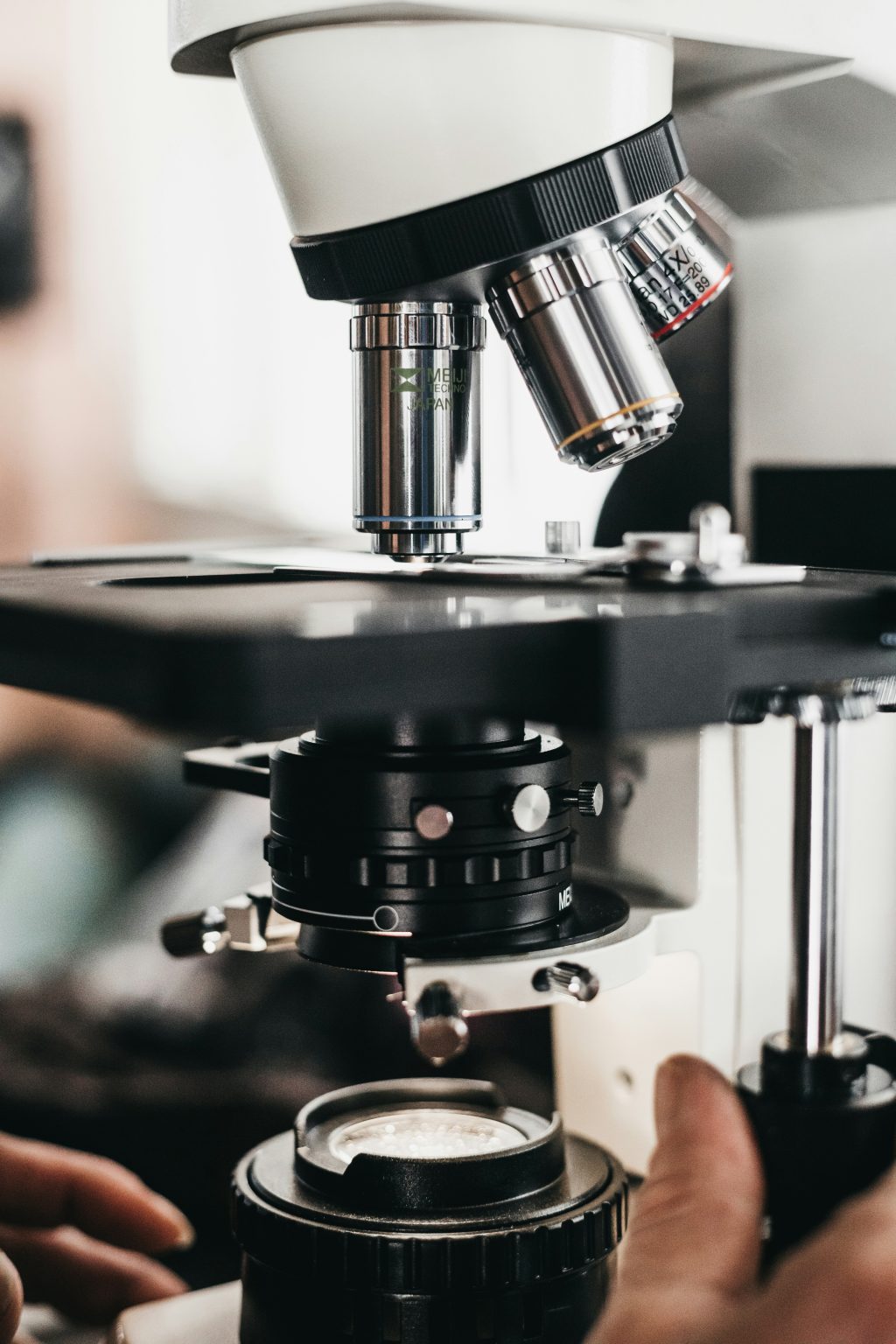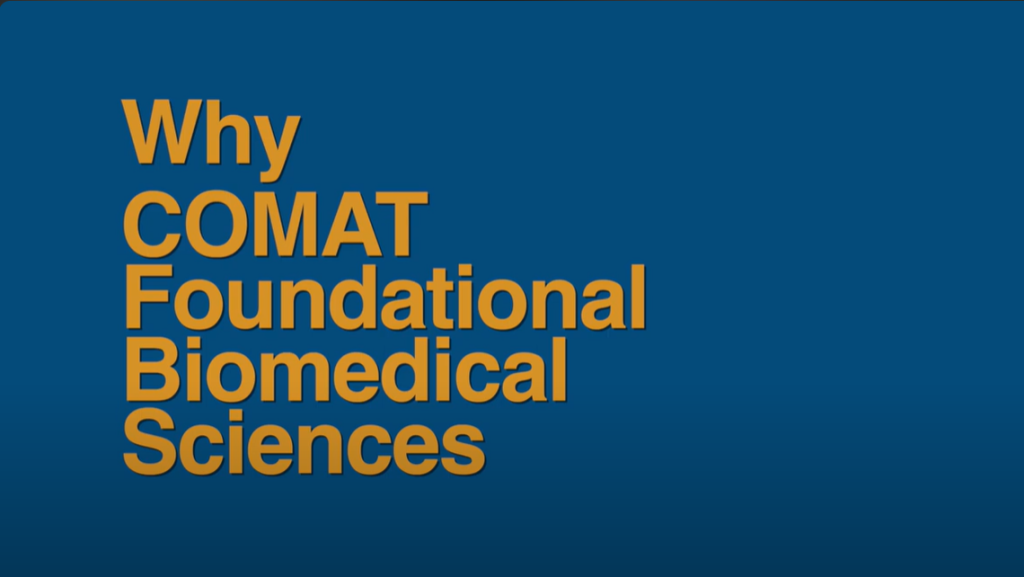COMAT FBS Targeted

About COMAT FBS Targeted
COMAT Foundational Biomedical Science Targeted (FBS-T) exams assess students’ knowledge related to a particular discipline or body system. Administered exclusively by schools and colleges of osteopathic medicine (COMs), this targeted approach enables schools to dynamically customize their portfolio of exams to best meet evolving formative assessment needs.

Format
COMAT FBS-T exams each have 65 items that must be completed within 1.5 hours. A 5-minute tutorial is provided before each exam begins. Every examination in the COMAT FBS-T series has multiple forms, and all are psychometrically equivalent in content covered, level of difficulty, and reliability, allowing COMs to administer a given COMAT FBS-T exam multiple times per year.
Why COMAT FBS?
Michael L. Smith, PhD, year 1 curriculum director and director of multidisciplinary programs at the Texas College of Osteopathic Medicine, discusses how COMAT FBS can help schools measure student progress toward COMLEX-USA Level 1.

Topics
| Topic | Percentage |
| Hematologic systems | 15–20% |
| Heart | 20–25% |
| Vasculature | 20–25% |
| Integrated neurohumoral control | 15–20% |
| Pharmacologic treatment of cardiovascular and hematologic disorders and dysfunctions | 15–20% |
| Topic | Percentage |
| Adrenal cortical and medullary hormones | 10–15% |
| Hypothalamic-pituitary axis | 10–15% |
| Parathyroid gland | 5–10% |
| Thyroid gland | 10–15% |
| Endocrine pancreas | 15–20% |
| Immunologic responses and autoimmune disorders | 5–10% |
| Bioenergetics and metabolism | 5–10% |
| Endocrine function of adipose tissue | 5–10% |
| Pharmacologic treatment of altered endocrine function | 10–15% |
| Topic | Percentage |
| Anatomy of the gastrointestinal system | 15-20% |
| Integrated neural and hormonal control throughout the GI tract (motility, secretion, satiety, thirst, appetite) | 20-25% |
| Gastric and intestinal motility, secretion, digestion and absorption | 20-25% |
| Hepatobiliary functions | 5-10% |
| Nutritional health | 5-10% |
| Diseases and disorders (autoimmune, infectious, and malignancies) | 15-20% |
| Pharmacologic treatment of GI system disorders and dysfunctions | 8-12% |
| Topic | Percentage |
| Anatomy of the genitourinary and renal systems | 5-10% |
| Function and regulation | 25-35% |
| Mechanisms of acid-base regulation | 30-35% |
| Diseases and disorders (autoimmune, infectious, and malignancies) | 8-12% |
| Pharmacologic treatment of the genitourinary and renal system disorders and dysfunctions | 10-15% |
| Topic | Percentage |
| Female reproduction | 25–35% |
| Male reproduction | 5–10% |
| Stages of growth and development | 10-15% |
| Genetics | 20–25% |
| Human sexual response | 5–10% |
| Pharmacologic and environmental influences on growth and development | 15-20% |
| Topic | Percentage |
| Anatomy of integumentary system | 25-30% |
| Physiological functions of the skin | 10-15% |
| Diseases and disorders (autoimmune, infectious, and malignancies) | 35-40% |
| Pharmacologic treatment of integumentary system disorders, dysfunctions, and infections | 15-20% |
| Topic | Percentage |
| Microscopic and gross structure of skeletal and smooth muscle | 25–30% |
| Microscopic and gross structure of bone | 20–25% |
| Microscopic and gross structure of joints | 20–25% |
| Acute and chronic injuries, disorders, and diseases | 15-20% |
| Pharmacology of the musculoskeletal system and the neuromuscular junction | 8-12% |
| Topic | Percentage |
| Anatomy of the respiratory system | 15-20% |
| Physiologic function of ventilation and its control | 30-35% |
| Determinants of respiratory patterns and control | 6-12% |
| Causes of hypoxemia and hypercapnia | 6-12% |
| Integrated control of respiratory function | 6-12% |
| Diseases and disorders (autoimmune, infectious, and malignancies) | 20-25% |
| Pharmacologic treatment of respiratory system disorders and dysfunction | 10-15% |
| Topic | Percentage |
| Biomolecules, cell, and molecular biology | 20–25% |
| Metabolism and nutritional biochemistry | 25–30% |
| Human genetics | 20–25% |
| Cell signaling | 10-15% |
| Hematology | 15-20% |
| Topic | Percentage |
| Head and neck anatomy | 25–30% |
| Back and extremity anatomy | 20–25% |
| Body cavities anatomy (viscera) | 25–30% |
| Histology/development | 20–25% |
| Topic | Percentage |
| Microanatomy of CNS structures | 5-8% |
| Meninges, ventricles, CSF | 5-8% |
| CNS development | 5-8% |
| Neuroplasticity | 5-8% |
| Spinal cord | 10-15% |
| Brainstem | 12-18% |
| Basal ganglia | 5-8% |
| Cerebellum | 5-8% |
| Thalamus | 5-8% |
| Hypothalamus | 5-8% |
| Cerebrum | 15-20% |
| Limbic structures | 5-8% |
| Topic | Percentage |
| Bacteriology | 25-30% |
| Virology | 25-30% |
| Mycology and parasitology | 15-20% |
| Immunology | 25-30% |
| Topic | Percentage |
| Basic principles of pharmacology | 10-18% |
| Chemotherapeutic agents | 10-15% |
| Foundational pharmacology of the nervous system | 15-22% |
| Foundational cardiovascular, renal, pulmonary, hematologic pharmacology | 15-22% |
| Foundational pharmacology of the endocrine system | 10-15% |
| Foundational pharmacology of the gastrointestinal system | 8-10% |
| Foundational pharmacology of the immune system | 10-12% |
| Topic | Percentage |
| Cellular physiology in health and disease | 5-10% |
| Systems physiology in health and disease | 60-75% |
| Acid-base regulation | 5-10% |
| Reflex control mechanisms in health and disease | 15-20% |
Supplementary Resources
The NBOME uses many supplementary resources to inform the development of the FBS exams, some of which are listed below.
| Title | Author/Editor | Edition | Year |
|---|---|---|---|
| Atlas of Anatomy | Gilroy, et al. | 4th | 2020 |
| Atlas of Human Anatomy | Netter | 7th | 2019 |
| Snell’s Clinical Anatomy by Regions | Wineski | 10th | 2019 |
| Essentials of Physical Medicine and Rehabilitation: Musculoskeletal Disorders, Pain, and Rehabilitation | Frontera & Silver | 4th | 2020 |
| Gray’s Anatomy for Students | Drake, Vogl, & Mitchell | 4th | 2019 |
| Gray’s Anatomy: the Anatomical Basis of Clinical Practice | Standring | 42nd | 2020 |
| Histology: A Text and Atlas | Pawlina & Ross | 8th | 2018 |
| Junquiera’s Basic Histology Text and Atlas | Mescher | 16th | 2022 |
| Langman’s Medical Embryology | Sadler | 14th | 2018 |
| Clinically Oriented Anatomy | Moore, Dalley, & Agur | 9th | 2022 |
| Neuroanatomy through Clinical Cases | Blumenfeld | 3rd | 2021 |
| Title | Author/Editor | Edition | Year |
|---|---|---|---|
| Harper’s Illustrated Biochemistry | Rodwell, et al | 32nd | 2022 |
| Lippincott Illustrated Reviews: Biochemistry | Ferrier | 8th | 2021 |
| Mark’s Basic Medical Biochemistry | Lieberman & Marks | 6th | 2022 |
| Medical Genetics | Jorde, Carey, & Bamshad | 6th | 2019 |
| Thompson & Thompson Genetics in Medicine | Nussbaum | 9th | 2019 |
| Title | Author/Editor | Edition | Year |
|---|---|---|---|
| AccessMedicine | Numerous titles | ||
| Current Medical Diagnosis & Treatment | Papadakis & McPhee | 61st | 2022 |
| Cecil Textbook of Medicine | Goldman & Schafer | 26th | 2019 |
| DynaMed Plus | Regularly updated | ||
| Textbook of Family Medicine | Rakel | 9th | 2016 |
| Harrison’s Principles of Internal Medicine | Jameson, Fauci, Kasper, Hauser, Longo, & Loscalzo | 21st | 2022 |
| Nelson’s Textbook of Pediatrics | Kliegman & Geme | 21st | 2019 |
| Essentials of Obstetrics and Gynecology | Hacker | 6th | 2016 |
| Tintinalli’s Emergency Medicine: A Comprehensive Study Guide | Tintinalli et al. | 9th | 2019 |
| Diagnostic and Statistical Manual of Mental Disorders (DSM) | APA | 5th (DSM-5) | 2013 |
| Synopsis of Psychiatry | Kaplan & Saddock | 12th | 2021 |
| Title | Author/Editor | Edition | Year |
|---|---|---|---|
| Jawetz, Melnick, and Adelberg’s Medical Microbiology | Riedel, Morse, Mietzner, & Miller | 28th | 2019 |
| Medical Microbiology | Murray, Rosenthal, & Pfaller | 9th | 2020 |
| Principles and Practice of Infectious Diseases; Volume 1 & 2 | Bennett, Dolin, & Blaser | 9th | 2019 |
| Principles and Practice of Infectious Diseases; Volume 2 | Mandell, Bennett, & Dolin | 9th | 2019 |
| The Sanford Guide to Antimicrobial Therapy | Gilbert, Eliopoulos, & Chambers | 48th | 2018 |
| Cellular and Molecular Immunology | Abbas, Lichtman, and Pillai | 10th | 2021 |
| Immunology | Male, Peebles, & Male | 9th | 2020 |
| Janeway’s Immunobiology | Murphy & Weaver | 10th | 2022 |
| Title | Author/Editor | Edition | Year |
|---|---|---|---|
| Basic Clinical Neuroscience | Young, Young, Tolbert | 3rd | 2015 |
| The Central Nervous System | Brodal | 5th | 2016 |
| Snell’s Clinical Neuroanatomy | Splittgerber | 8th | 2018 |
| Essential Neuroscience | Siegel & Sapru | 4th | 2018 |
| Fundamental Neuroscience | Haines & Mihailoff | 5th | 2017 |
| Neuroanatomy Atlas in Clinical Context | Haines | 10th | 2018 |
| Neuroanatomy through Clinical Cases | Blumenfeld | 3rd | 2021 |
| Adams and Victor’s Principles of Neurology | Ropper, Samuels, Klein, & Prasad | 11th | 2019 |
| Bradley and Daroff’s Neurology in Clinical Practice; Volumes 1 & 2 | Jankovic, Mazziotta, Pomeroy, & Daroff | 8th | 2021 |
| Localization in Clinical Neurology | Brazis, Masdeu, & Biller | 7th | 2016 |
| Orthopaedic Neurology: A Diagnostic Guide to Neurologic Levels | Hoppenfeld & Hoppenfeld | 2nd | 2017 |
| Practical Neurology | Biller | 5th | 2019 |
| Title | Author/Editor | Edition | Year |
|---|---|---|---|
| Basic and Clinical Pharmacology | Katzung | 15th | 2020 |
| Drug Facts and Comparisons | Kastrup | 70th | 2016 |
| Goodman & Gilman’s The Pharmacological Basis of Therapeutics | Brunton, Chabner, & Knollman | 14th | 2022 |
| Lippincott’s Illustrated Reviews: Pharmacology | Whalen, Radhakrishnan, & Feild | 8th | 2022 |
| Pharmacotherapy: A Pathophysiologic Approach | Dipiro, Talbert, Yee, Matzke, Wells, & Posey | 11th | 2020 |
| Stahl’s Essential Psychopharmacology | Stahl | 5th | 2021 |
| Title | Author/Editor | Edition | Year |
|---|---|---|---|
| Berne & Levy Physiology | Koeppen, Stanton | 7th | 2018 |
| Ganong’s Review of Medical Physiology | Barrett, Barman, Yuan, & Brooks | 26th | 2019 |
| Guyton and Hall Textbook of Medical Physiology | Hall & Hall | 14th | 2020 |
| Medical Physiology | Boron & Boulpaep | 3rd | 2016 |
| Physiology | Costanzo | 7th | 2021 |
Additional References
Biochemistry
“DNA Replication Objectives.” Association of Biochemistry Educators. 2011.
Biochemistry
“Blood Objectives.” ABE. 2011.
Biochemistry
“Carbohydrate Metabolism Objectives.” ABE. 2011.
Biochemistry
“Lipid Metabolism Objectives.” ABE. 2011.
Biochemistry
“Signaling Hormones and Diabetes Objectives.” ABE. 2011.
Biochemistry
“Protein and Amino Acid Metabolism Objectives.” ABE. 2011.
Biochemistry
“Nucleotide Metabolism Objectives.” ABE. 2011.
Biochemistry
“Medical Biochemistry Competencies (with UME appendix).” ABE. 2011.
Genetics
“Medical School Core Curriculum in Genetics.” Association of Professors of Human and Medical Genetics. 2013.
Microbiology and Immunology
“General Principles of Foundational Science: Microbial biology. Immune System.” USMLE Content Outline (pp. 3-5). National Board of Medical Examiners. 2015.
Pharmacology
“Knowledge Objectives in Medical Pharmacology.” Association of Medical School Pharmacology Chairs. 2012.
Physiology
“Medical Physiology Learning Objectives.” The American Physiological Society and the Association of Chairs of Departments of Physiology. 2012.
